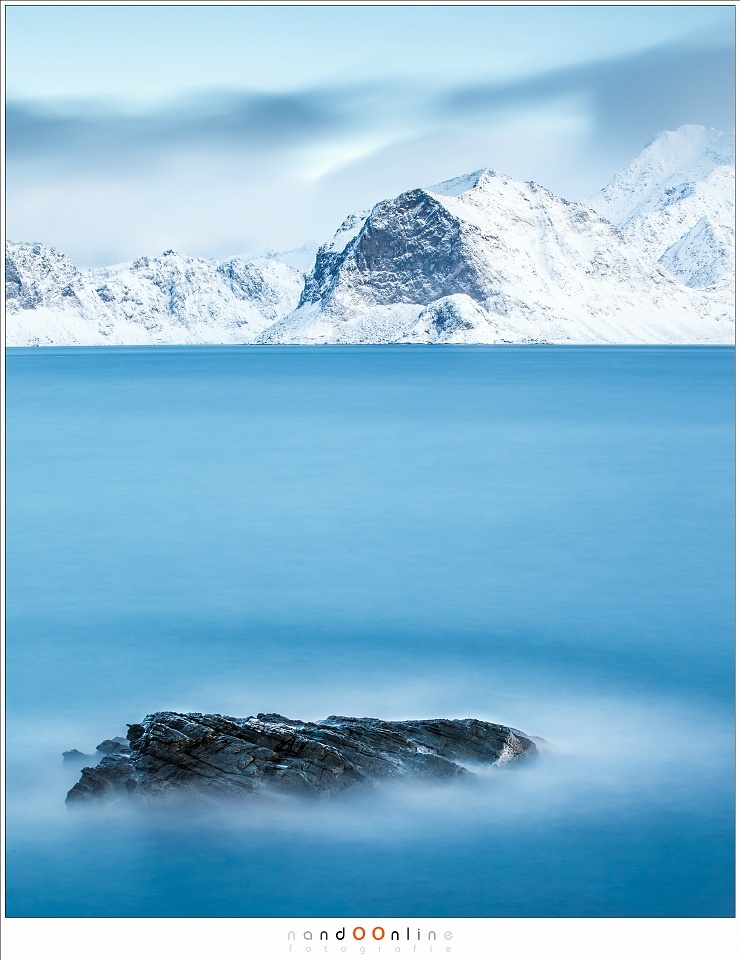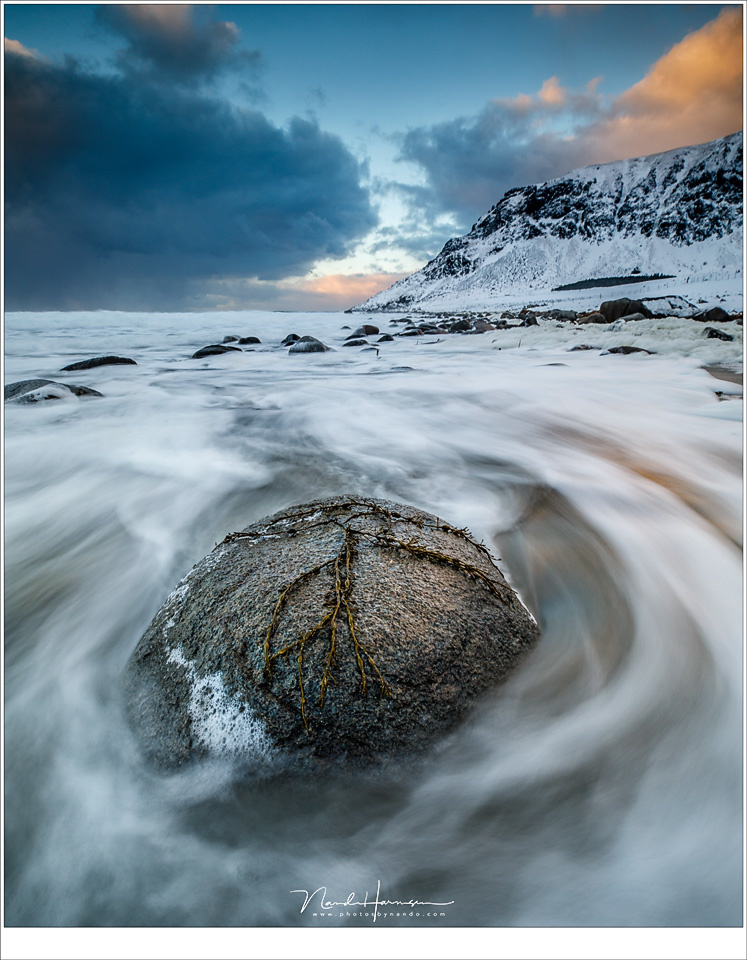When photographing landscapes with a wide-angle lens, you probably want something in the foreground, to give the photo some extra depth. It can make your landscape photo more interesting to look at. Just make sure your foreground subject is interesting enough.
There are a few ingredients that make a good landscape photo. Good light is obvious, perhaps even the most important of all. But also a good composition with leading lines and an interesting location can make or break a photo. We often choose for a wide-angle lens, or perhaps even an ultra-wide-angle lens, to get as much as possible in the frame, together with a nice object in foreground to add some depth. If possible, we crawl within a few centimeters distance, making the foreground subject very large in comparison with the rest of the landscape. Combine these things in the proper way and you can end up with an award winning photo.

A subject that tells a story. It is an interesting foreground that adds value to this landscape photo. (Nikon Z 7 26mm | ISO900 | f/11 | 1/60)
But you need to be careful. Crawling with your ultra-wide-angle lens right up to that object will make it probably your main subject. Suddenly the landscape has become a backdrop; it is no longer the most important thing in the photo. That doesn’t have to be a problem, of course. If the image has enough leading lines to take the viewer to the background it will be great. Since the object in the foreground has all the attention, you’ll have to make sure it is an interesting object.

A subject in the foreground is only interesting if it adds value. The grass in this landscape photo does not very interesting and the photo has no benefit from it. That is what I think. (Canon EOS 5D3 17mm | ISO100 | f/11 | 1/10)
Having an object in the foreground of your landscape photo is not mandatory, not even with an ultra-wide-angle. An uninteresting stone will be very boring, unless it is a very important element of the photo. Also, simple branches, plants, or just grass may will not be very interesting, and it might even work as a distraction. In worst cases it can block the view. That is why it is wise to choose only an interesting object, that works as an addition. If it doesn’t contribute, simply leave it out.
I took some images of a tree in a nearby moorland as an example. First I used the grass as a foreground, something you might try in order to give the photo some interesting depth. But it doesn’t work. The grass is not very interesting and adds nothing of value to the photo. Not in this way, at least. When I looked around, something you should always do when you are at a location, I noticed a bed of white flowers that could make it more interesting.

I used the grass as a foreground, but it is not convincing. I would rather see something more interesting instead of that grass (Panasonic S1 24mm | ISO100 | f/11 | 1/125)

I found a bed of flowers that is more interesting as a foreground subject. But I had to use a longer focal length to prevent the tree from becoming too small in the frame (Panasonic S1 50mm | ISO100 | f/11 | 1/200)
And indeed, these flowers are much more interesting compared to the grass. It adds a lot of extra value to the photo. There are a lot of different compositions possible, different ways to place this bed of flowers in the frame and relative to the tree. You might even consider zooming in a bit, and play with the relative size of the flowers and tree. I choose a very low point of view, shooting through the flowers with the tree in focus. After all, I wanted the tree as a subject.

To make the photo more interesting, I took a very low point of view. Imagine this photo during a sunset. I could become quite stunning. (Panasonic S1 50mm | ISO100 | f/11 | 1/125)
I was lucky to find these flowers at this location. If you cannot find anything that can serve as a good foreground object, you might consider a photo without it. Don’t try to make something out of nothing. It probably won't work, or even work against you.

If you cannot find a good subject in the foreground, consider not using a foreground at all. I choose a central composition for this photo. (Panasonic S1 24mm | ISO100 | f/11 | 1/125)
Without a foreground subject I choose a central composition. Nevertheless, I don’t think I have a really interesting photo this way. But in this case the tree worked well as an example to make my point. Perhaps I will return to this tree within a few weeks, when the sun will set behind this tree, and see how it works out.
In the meanwhile, let me show a couple of examples with an object in the foreground, and let you decide if that object is interesting enough to serve as a foreground.

Sunset in a nearby moorland. The water was so low, the bottom appeared at the surface. (Canon EOS 5D3 80mm | ISO100 | f/11 | 1/1600)

This object in the foreground is interesting enough, and works as a leading line towards the castle. (Mavic Phantom 3 advanced drone | ISO100 | f/2,8 | 1/710)

A small round pool that reflects the waterfall, worked perfectly as a foreground subject. If has also become the subject in the frame. (Canon EOS 5D4 16mm | ISO100 | f/11 | 1/8)

A fjord at Lofoten, Norway, during winter, shot with a Haida Super Stopper (Canon EOS 1Dx 70mm | ISO200 | f/11 | 242s)

Only a stone as a subject in the foreground is not that interesting, unless it tells a story and becomes part of the other elements in the landscape. This stone tells that story. (Canon EOS 5D4 16mm | ISO100 | f/13 | 1,3s)

A vertical panorama of the moorland in the Netherlands, with a beautiful sky filled with clouds that refused to turn red at sunset. (Canon EOS 5D4 17mm | ISO100 | f/11 | shutterspeed unknown)
Bottom line; an object in the foreground can make your landscape photo very interesting. But only if the object is interesting enough, and adds value to the photo. Otherwise, just leave it out of the frame.
Do you always want a foreground object in your landscape photo, no matter what? Or are you critical about it? I would love to read about it in the comments.








I really enjoyed your take and explanations on this. I think we have all heard it by now but you complimented it with great examples. There seems to be a bit of a glut of authors coming onto Fstoppers who think cranking the saturation slider to the unprintable right is great photography. It is an extra bonus that you don't do that. All scenes were very believable.
In general I want an interesting foreground element but if it's not there that doesn't necessarily mean the photo is not worth taking. I would rather leave it out than have a mediocre foreground element just to have one.
Agreed. Moreover, some of the examples demonstrate the forced, cliched approach of adding something plopped in the foreground to simply create an element in the foreground. The shell and rock images are examples. I find having foreground elements which pull the viewer into the photo more powerful and interesting than formulaic.
I agree. But I also think there are two kinds of foreground possible. Like the shell; it is a photo of the shell, on a beach during sunset. The shell is subject. The other foreground is something that will lead to the landscape itself, which is the main subject.
These are two kinds of foreground uses.
Thanks for your comment, Ed
As long as the foreground subject isnt straight up battling with the landscape i like to add it. A good example here is that small pool of water and a waterfall in the back. They compliment each other and aren't battling for the right to be the subject of the photo
Good point. Choose your subject - one of the more important things in landscape photography (I also wrote an article about that previously)
Very nice article, very inspiring !
My main problem is that I hate portrait oriantation shot.